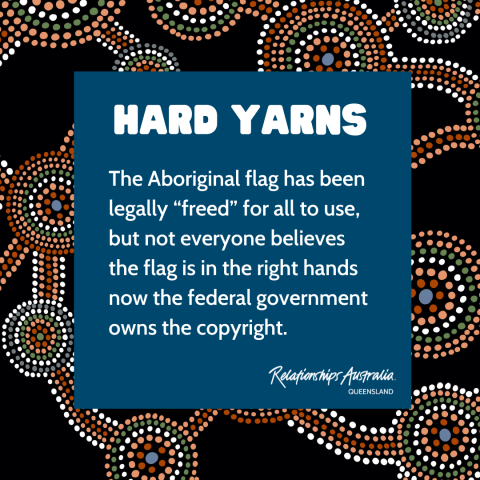
We’re aware this content may cause distress for some people. We encourage you to seek trauma-informed and culturally appropriate support from a trusted professional.
Readers are advised to hold a trauma-informed approach through any sharing of materials on this page.
Lifeline: 13 11 14
13YARN: 13 92 76
For the first time, the Aboriginal flag can be used freely by all Australians.
A few days before Invasion Day 2022, Prime Minister Scott Morrison announced the federal government had “freed the Aboriginal flag for Australians” by buying the copyright from Harold Thomas, the Luritja artist who created it over 50 years ago.
"When I created the flag, I created it as a symbol of unity and pride. That pride we have for our identity that harks back to the birthing of our dreaming, to the present existence and beyond,” says Mr Thomas.
The “Free the Flag” campaign was launched by Aboriginal-owned-and-led business Clothing the Gaps in 2019. They had received cease and desist letters from a non-Indigenous company, WAM Clothing, demanding they stop using the Aboriginal flag on their clothing.
Then-copyright owner Mr Thomas had granted WAM Clothing exclusive rights for use of the flag on its clothing. This meant anyone else wanting to use the flag on clothing – even non-commercially – had to get permission from the WAM first.
The #freetheflag campaign demanded new licensing agreements over the Aboriginal flag's design, especially for First Nations businesses and organisations. Clothing the Gaps started a petition that gathered more than 165,000 signatures and high-profile supporters from across Australia, and earlier this year, the flag was freed.
The flag has had its share of controversy and control over the years.
Cathy Freeman was almost penalised for carrying both the Australian and Aboriginal flags during her 1994 Victoria Commonwealth Games victory laps for the 400m and 200m sprints.
Despite this controversy, Ms Freeman again carried both flags during her 2000 Olympic Games victory lap in the 400m sprint – a symbol of reconciliation and pride in her Aboriginal cultural heritage.
Although the copyright settlement is a practical solution to a controversial problem, some people are disappointed that the federal government now owns the exclusive rights to reproduce the Aboriginal flag.
Gunnai Gunditjmara and Djab Wurrung woman Senator Lidia Thorpe explains:
"I felt shock horror that the colonial system that has hurt our people for so long now has the copyright to the one thing that united Aboriginal people across this country.”
She explained that many people in the First Nations community hoped the government would pay for the copyright to be ended, but the flag should have been returned to First Nations Peoples rather than kept.
While we celebrate that the flag has been legally “freed” for all to use, we must understand and respect that not everyone believes the flag is in the right hands now the Commonwealth owns the copyright.
It can be argued that this approach does not uphold the autonomy and self-determination of Australia's First Nations Peoples.
Mr Thomas says he hopes the democratisation of the flag will "provide comfort to all Aboriginal people and Australians to use the flag".
"I am grateful that my art is appreciated by so many, and that it has come to represent something so powerful to so many.”
